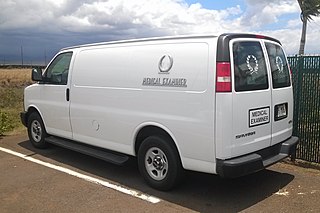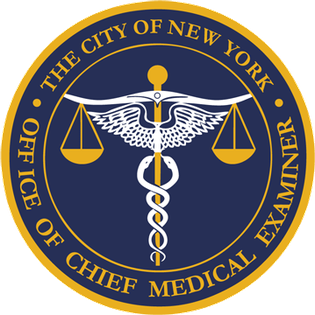A coroner is a government or judicial official who is empowered to conduct or order an inquest into the manner or cause of death, and to investigate or confirm the identity of an unknown person who has been found dead within the coroner's jurisdiction.

The New York City Fire Department, officially the Fire Department of the City of New York (FDNY), is an American department of the government of New York City that provides fire protection services, technical rescue/special operations services, chemical, biological, radiological, nuclear and high-yield explosive/hazardous materials response services and emergency medical response services within the five boroughs of New York City.

The medical examiner is an appointed official in some American jurisdictions who is trained in pathology that investigates deaths that occur under unusual or suspicious circumstances, to perform post-mortem examinations, and in some jurisdictions to initiate inquests.

Susannah Lattin was an American woman who died of a postpartum infection at an illegal maternity clinic at 6 Amity Place in New York City, operated by Henry Dyer Grindle. Her death led to an investigation which resulted in regulation of maternity clinics and adoptions in New York City in 1868.

New York City, the most populous city in the United States, is composed of five boroughs: The Bronx, Brooklyn, Manhattan, Queens, and Staten Island. Each borough is coextensive with a respective county of New York State. The boroughs of Queens and the Bronx are also Queens County and Bronx County. The other three counties are named differently from their boroughs: Manhattan is New York County, Brooklyn is Kings County, and Staten Island is Richmond County.
New York's 14th congressional district is a congressional district for the United States House of Representatives located in New York City, represented by Democrat Alexandria Ocasio-Cortez.

The New York City Department of Sanitation (DSNY) is the department of the government of New York City responsible for garbage collection, recycling collection, street cleaning, and snow removal. The DSNY is the primary operator of the New York City waste management system.
Henry Dyer Grindle was a Manhattan physician and abortion provider in the 1870s who worked under the name H.D. Grindle.

Lester David Volk was an American physician, lawyer and politician from New York.

The Office of Chief Medical Examiner of the City of New York (OCME) is a department within the city government that investigates cases of persons who die within New York City from criminal violence; by casualty or by suicide; suddenly, when in apparent good health; when unattended by a physician; in a correctional facility; or in any suspicious or unusual manner. The OCME also investigates when an application is made pursuant to law for a permit to cremate the body of a deceased person.

The New York City Sheriff's Office (NYCSO), officially the Office of the Sheriff of the City of New York, is the primary civil law enforcement agency for New York City. The Sheriff's Office is a division of the New York City Department of Finance, operating as an enforcement arm. The Sheriff's Office handles investigations concerning cigarette tax enforcement, real estate property/deed fraud and other matters deemed necessary by the Department of Finance.

John Edward West Thompson was an American physician and diplomat. His parents were immigrants to New York City from Haiti. In 1884, after graduating from Yale University and studying medicine further in Europe, Thompson became one of the first African-American physicians to practice in New York City.

George Frederick Shrady Jr. M.D. was the Coroner of New York County, New York, in 1906, and head of the Aqueduct Police.

USS Surf (SP-518) was a steam yacht that was offered to the United States Navy in 1917 but was never accepted.

Charles Norris was New York's first appointed chief medical examiner (1918–1935) and pioneer of forensic toxicology in America.

Israel Lewis Feinberg, M.D. was a physician and the Coroner of New York County, New York, from 1910 to 1918, where he served as president of the board of coroners.
A coroner in Washington state is a quasi-judicial, public official principally charged with the certification of human death. It is completely identical in authority to the parallel office of medical examiner, which also exists in the state. Washington uses a "mixed system" of death investigation with some counties employing coroners, and some employing medical examiners.

Abraham J. Berry, a physician, was the first mayor of "the independent city of Williamsburgh."





















